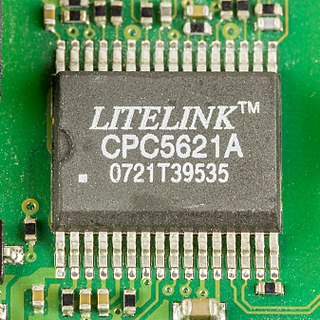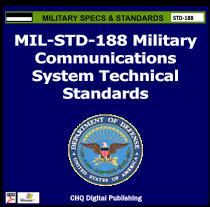In telecommunications, RS-232, Recommended Standard 232 refers to a standard originally introduced in 1960 for serial communication transmission of data. It formally defines signals connecting between a DTE such as a computer terminal, and a DCE, such as a modem. The standard defines the electrical characteristics and timing of signals, the meaning of signals, and the physical size and pinout of connectors. The current version of the standard is TIA-232-F Interface Between Data Terminal Equipment and Data Circuit-Terminating Equipment Employing Serial Binary Data Interchange, issued in 1997. The RS-232 standard had been commonly used in computer serial ports and is still widely used in industrial communication devices.

Frame Relay is a standardized wide area network technology that specifies the physical and data link layers of digital telecommunications channels using a packet switching methodology. Originally designed for transport across Integrated Services Digital Network (ISDN) infrastructure, it may be used today in the context of many other network interfaces.

The term data access arrangement (DAA) has the following meanings:
- In public switched telephone networks, a single item or group of items at the customer side of the network interface for data transmission purposes, including all equipment that may affect the characteristics of the interface.
- A data circuit-terminating equipment (DCE) supplied or approved by a common carrier that permits a DCE or data terminal equipment (DTE) to be attached to the common carrier network.
A data service unit, sometimes called a digital service unit, is a piece of telecommunications circuit terminating equipment that transforms digital data between telephone company lines and local equipment. The device converts bipolar digital signals coming ultimately from a digital circuit and directly from a Channel service unit (CSU), into a format compatible with the piece of data terminal equipment (DTE) to which the data is sent. The DSU also performs a similar process in reverse for data heading from the DTE toward the circuit. The telecommunications service a DSU supports can be a point-to-point or multipoint operation in a digital data network.
In telecommunication, data signaling rate (DSR), also known as gross bit rate, is the aggregate rate at which data pass a point in the transmission path of a data transmission system.
- The DSR is usually expressed in bits per second.
- The data signaling rate is given by where m is the number of parallel channels, ni is the number of significant conditions of the modulation in the i-th channel, and Ti is the unit interval, expressed in seconds, for the i-th channel.
- For serial transmission in a single channel, the DSR reduces to (1/T)log2n; with a two-condition modulation, i. e. n = 2, the DSR is 1/T, according to Hartley's law.
- For parallel transmission with equal unit intervals and equal numbers of significant conditions on each channel, the DSR is (m/T)log2n; in the case of a two-condition modulation, this reduces to m/T.
- The DSR may be expressed in bauds, in which case, the factor log2ni in the above summation formula should be deleted when calculating bauds.
- In synchronous binary signaling, the DSR in bits per second may be numerically the same as the modulation rate expressed in bauds. Signal processors, such as four-phase modems, cannot change the DSR, but the modulation rate depends on the line modulation scheme, in accordance with Note 4. For example, in a 2400 bit/s 4-phase sending modem, the signaling rate is 2400 bit/s on the serial input side, but the modulation rate is only 1200 bauds on the 4-phase output side.
In telecommunication, a data transmission circuit is the transmission media and the intervening equipment used for the data transfer between data terminal equipment (DTEs).

A data circuit-terminating equipment (DCE) is a device that sits between the data terminal equipment (DTE) and a data transmission circuit. It is also called data communication(s) equipment and data carrier equipment. Usually, the DTE device is the terminal, and the DCE is a modem.
In telecommunication, an interchange circuit is a circuit that facilitates the exchange of data and signaling information between data terminal equipment (DTE) and data circuit-terminating equipment (DCE).
A sequence of events is isochronous if the events occur regularly, or at equal time intervals. The term isochronous is used in several technical contexts, but usually refers to the primary subject maintaining a constant period or interval, despite variations in other measurable factors in the same system. Isochronous timing is a characteristic of a repeating event whereas synchronous timing refers to the relationship between two or more events.
In electronics and telecommunications, jitter is the deviation from true periodicity of a presumably periodic signal, often in relation to a reference clock signal. In clock recovery applications it is called timing jitter. Jitter is a significant, and usually undesired, factor in the design of almost all communications links.
Data transmission is the transfer of data over a point-to-point or point-to-multipoint communication channel. Examples of such channels are copper wires, optical fibers, wireless communication channels, storage media and computer buses. The data are represented as an electromagnetic signal, such as an electrical voltage, radiowave, microwave, or infrared signal.

Null modem is a communication method to directly connect two DTEs using an RS-232 serial cable. The name stems from the historical use of RS-232 cables to connect two teleprinter devices or two modems in order to communicate with one another; null modem communication refers to using a crossed-over RS-232 cable to connect the teleprinters directly to one another without the modems. It is also used to serially connect a computer to a printer, since both are DTE, and is known as a Printer Cable.

Link Access Procedure, Balanced (LAPB) implements the data link layer as defined in the X.25 protocol suite. LAPB is a bit-oriented protocol derived from HDLC that ensures that frames are error free and in the correct sequence. LAPB is specified in ITU-T Recommendation X.25 and ISO/IEC 7776. It implements the connection-mode data link service in the OSI Reference Model as defined by ITU-T Recommendation X.222.

A Medium Attachment Unit (MAU) is a transceiver which converts signals on an Ethernet cable to and from Attachment Unit Interface (AUI) signals.
In data communications, flow control is the process of managing the rate of data transmission between two nodes to prevent a fast sender from overwhelming a slow receiver. It provides a mechanism for the receiver to control the transmission speed, so that the receiving node is not overwhelmed with data from transmitting node. Flow control should be distinguished from congestion control, which is used for controlling the flow of data when congestion has actually occurred. Flow control mechanisms can be classified by whether or not the receiving node sends feedback to the sending node.
In digital communications, symbol rate, also known as baud rate and modulation rate, is the number of symbol changes, waveform changes, or signaling events across the transmission medium per time unit using a digitally modulated signal or a line code. The symbol rate is measured in baud (Bd) or symbols per second. In the case of a line code, the symbol rate is the pulse rate in pulses per second. Each symbol can represent or convey one or several bits of data. The symbol rate is related to the gross bitrate expressed in bits per second.
Packet Layer Protocol or PLP is the Network Layer protocol for the X.25 protocol suite. PLP manages the packet exchanges between DTE devices across VCs. PLP also can be used on ISDN using Link Access Procedures, D channel (LAPD).
ANT is a proprietary multicast wireless sensor network technology designed and marketed by ANT Wireless. It is primarily used for sports and fitness sensors. ANT was introduced by Dynastream Innovations in 2003, followed by the low-power standard ANT+ in 2004, before Dynastream was bought by Garmin in 2006.










